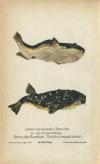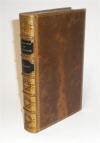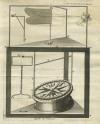Livre de prières tissé d’après les enluminures des manuscrits du XIVe au XVIe si…
Livre de prières tissé d’après les enluminures des manuscrits du XIVe au XVIe si
|
SILK BOOK – JACQUARD – Livre de prières tissé d’après les enluminures des manuscrits du XIVe au XVIe siècle. Lyon, A. Roux, 1886 (″achevé … le VIII Sept. l’an de N.S. 1887“). Small 8vo. 1 w. Bl., 25 beidseitig gewebte Bll., 1 w. Bl. Mit 3 ganzseit. Ill., Frontispiz mit leergelassenem Wappen, zahlreichen Initialen u. durchgehenden floralen bzw. figürlichen Bordüren nach mittelalterlichen illuminierten Stundenbüchern. Text and illustrations entirely woven on a Jacquard machine with black and silver silk. Precious contemporary morocco leather in Jansenist-style, 5 raised bands, board edges with double gilt fillet, top and bottom edge gilt, doublures with burgundy moiré silk endpapers and inside boards with gilt tooled borders (dentelles, floral motifs and fillets). Binding signed J. Kaufmann and Ch. Meunier. Front board slightly concave. Dampstains throughout, mostly on the bottom margins and only spreading on the first and last one or two leaves, on the first few pages also affecting the top outer corners. All leaves with neat edges and free of any fraying. Overall in good condition. Extremely rare, with only about 50 flawlessly woven copies. Vicaire V, 342. – P. Marais, „Note sur un livre de prières en tissue de soie“, in: Bulletin du Bibliophile, 1889, S. 163-166. – A. Laillier, „Une merveille artistique: notice sur un livre de prières tissé en soie“, in: Bulletin de la Société industrielle de Rouen, 1er janvier 1890, S. 267-270. – Michael Laird in The World from Here. Treasures of the Great Libraries of Los Angeles (edited by C. Burlingham & B. Whiteman, 2001), 63. „Despite the fact that this rare volume is not a printed book, it is of singular interest in that it was completely woven with silver and black silk thread. It also represents an extremely early book production involving automation and programming… The book was manufactured on silk looms that were programmed using the punched-card system developed by Joseph-Marie Jacquard (1752-1834). Several hundred thousand cards were required to program this curious magnum opus (the actual figure is not known, but estimates range from 106,000 to 500,000). After fifty failed attempts, it took two years to weave approximately sixty copies… It will be observed that the weave in the present volume is almost microscopic (it is exactly four hundred weft threads for every 2.5 centimeters [approximately one inch])… The movement of the machine was limited to one tenth of a millimeter, the result being an extremely precise piece of bookmaking, which, on account of the material used, truly gleams. It is noteworthy that Jacquard’s looms, only slightly modified, are still in use today, producing some of the world’s finest fabric for furniture. The punched instructional cards utilized by Jacquard’s weaving machinery served as the primary inspiration for the famous ‚Analytical Engine‘ conceived by Charles Babbage (1791-1871)“. – A highlight of Jacquard production from Lyon, the capital of silk and hometown of Joseph Marie Jacquard, and possibly the only successful attempt at weaving a complete book with legible text. After weaving, the silk leaves were folded and mounted on cardboard to give them the necessary strength. Each copy of the book was individually bound when sold, but many copies remained in stock for years. – Lillian Randall noted that the „illuminations“ of this particular prayer book came from a late 19th-century monograph, the „Imitation de Jésus-Christ“ (Paris: Gruel et Engelmann), which included reproductions of various illuminated manuscripts from the 14th to 16th century. The illuminations were chosen by R. P. J. Hervier, who was also responsible for the overall design of the volume. A copy of the book was exhibited in the Lyon Pavilion at the Universal Exhibition in 1889, where its maker, J. A. Henry, won the Grand Prix. – With its small format, the iconography and the general aesthetic featuring tendrils, fillets, miniatures, and initials, this work was clearly modelled on medieval books of hours. Just as a medieval manuscript was often tailored to the commissioner by inserting his coat of arms into a composition or by mentioning a saint to whom he was particularly devoted to, this book of hours has a coat of arms in the frontispiece, whose field remains empty to possibly embroider the coat of arms, the name and the motto of the recipient. In our copy, the field was left blank.
Unser Preis: EUR 15.000,-- |




